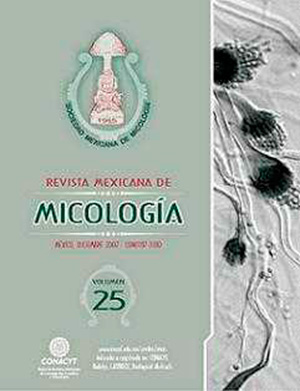Morphological varieties of Trichophyton rubrum clinical Isolates
DOI:
https://doi.org/10.33885/sf.2007.3.996Keywords:
Dermatophytosis, dermatophytesAbstract
Trichophyton rubrum is the worldwide most frequently isolated anthropophilic
dermatophyte causing superficial mycosis. Several morphological varieties of this
dermatophyte have been reported, making its identification sometimes difficult. Our aim
was to identify and to determine the frequency of the different morphological varieties
among the T. rubrum isolates in Mexico. One hundred and thirty one isolates, obtained from
patients with dermatophytosis were studied. The different morphological varieties were
evaluated by their macroscopic and microscopic features of isolates growing on three
different media, by the urease production and by their in vitro hair perforation capability.
Using these criteria, six morphological varieties were identified, being the most frequent the
“Y”, typical downy, and flava varieties. In this study we found that although T. rubrum presents
several morphological varieties, only three of them were more frequently found among
isolates of Mexico, which could indicate differences in their capacity to cause infection.
Downloads
Downloads
How to Cite
Issue
Section
License
Copyright notice
Open access policy
The authors who publish in this journal accept the following conditions:
In accordance with copyright laws, Scientia Fungorum recognizes and respects the authors’ moral rights, as well as the ownership of property rights, which will be transferred to the journal for dissemination in open access. Scientia Fungorum does not charge for submission and processing of articles for publication.
All the texts published by Scientia Fungorum –with no exception– are distributed under a Creative Commons License Attribution-NonCommercial-ShareAlike 4.0 International (CC BY-NC-SA 4.0), which allows third parties to use the publication as long as the work’s authorship and its first publication in this journal are mentioned.
The authors can enter into independent and additional contractual agreements for the nonexclusive distribution of the version of the article published in Scientia Fungorum (for example include it into an institutional repository or publish it in a book) as long as it is clearly and explicitly indicated that the work was published for the first time in Scientia Fungorum.
For all the above, the authors shall send the form of Letter-transfer of Property Rights for the first publication duly filled in and signed by the author(s). This form must be sent as a complementary file.
This work is licensed under a Creative Commons Attribution-NonCommercial-ShareAlike 4.0 International license (CC-By-NC-SA 4.0).



